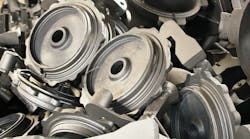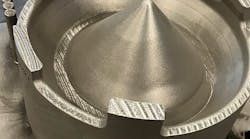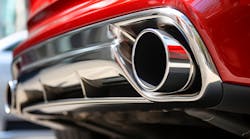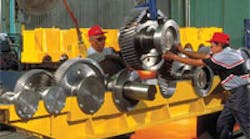If you’ve got equipment and products to move around your plant, you’re probably relieved to have a crane or hoist, or more than one, to keep the work moving. But, if you’ve got a crane or a hoist you probably have the various problems that go along with them.
1. The right controls
Assuming that operator training is in compliance to equipment standards and up-to-date with current safety regulations, there remains a vital question for crane operators: is the equipment capable of any random task required of it? With the right crane control program, you’ll know. Konecranes, designs and builds overhead cranes, and its control system for crane and hoist safety, condition, and performance control — ConrolPro — manages heavy loads so that foundries and other heavyduty manufacturing operations can maintain high-productivity without compromising performance or availability.
Konecranes (www.konecranesamericas.com) contends that ControlPro will increase personnel and equipment safety by avoiding overloading and allowing the operators to customize their maximum load limits. Other key benefits of the ControlPro include: increased productivity, valuable information, improved control in less time, and continuous control. The system is outfitted with several control modules:
- ControlPro Perform lets operators adjust speeds for faster positioning and smooth load handling. Smooth starts, stops, speed changes, and directional changes are offered for two-speed hoisting applications. It also helps to reduce equipment wear and mechanical stresses.
- ControlPro Lifetime collects useful information on hoist usage, and provides valuable information for measuring, calculation, and monitoring. The data can be used to plan maintenance according to actual hoist usage, rather than on length of service, which will improve planning and increase hoist uptime.
- ControlPro Optic is a pendant controller equipped with easy-to-use and -read displays showing load and other pertinent data. The module also lets the user check crane usage and condition at any time, conserving time, reducing risk, and enhancing performance.
- ControlPro Multicare is a module for continuous control of several hoists on a crane. The sum of the load of each hoist on the bridge is vital information (i.e, to avoid overload when the capacity of a crane is less total lifting capacity of individual hoists) that is displayed to the operator by a display on the pendant controller.
2. The right equipment
Assuming the operators are doing their jobs right and the control programs are properly managed, there may be problems with equipment. In other words, you may need to consider specially developed , taskoriented cranes and hoists. Gorbel Industries (www.gorbel.com) builds enclosed-track workstation cranes industry, including various overhead systems like ceiling-mounted bridge cranes and monorails, freestanding workstation bridge cranes, and workstation jib cranes. It develops installations for various purposes, such as the workcell jib crane at Nissan Castings, which delivers and removes transmission castings for a machining operation.
The Nissan Castings installation is built around Gorbel’s EasyArm “intelligent lifting/ balancing devices, and it combines a patented lifting technology (G-Force) with a PC-controlled electric servo-drive system. G-Force technology combines software and sensors with electric servopower to achieve speed, precision, and responsive performance.
Another castings manufacturer uses G-Force technology to lift finished 55-lb. products, two at a time, from a mold and transport them to a CNC machining station. From there, machined castings are taken as units and placed on a conveyor for further processing. This procedure is conducted 15 times/hour between three workstations in a 400-ft2 area, demonstrating the speed and precision G-Force allows.
G-Force systems can be configured for use with a freestanding hoist or one mounted overhead, and the installations can be optioned with different features. This might include a “float mode,” which lets operators orient the load precisely through a full-stroke range by guiding it manually, thus making an object essentially weightless for the worker. Another option is the portable base, which adds flexibility to the plant layout. Gorbel also offers a range of tooling for the EasyArm, and various control pendants or handles to suit different performance needs.
3. Maintenance
Assuming a foundry has the right lifting equipment and the right lifting control systems, there is still the common problem of maintenance. Konecranes offers detailed, customized, and comprehensive maintenance studies for all makes and models of process cranes. Teams of specialists conduct the Crane Reliability Surveys, and the results provide customers with insights that will help them achieve the highest lifecycle value for their lifting equipment.
A CRS starts with the team studying equipment documentation, interviewing operators, and applying advanced diagnostics to inspect and profile the equipment. The survey can uncover problems that cannot be detected by standard regulatory inspections, and if problems are detected the customer can address them prior to failures.
The process also may help improve crane performance and reliability by providing guides to repairs or modernizations. Knowing what repairs may be needed will allow the plant operators to make longterm maintenance plans, which supports productivity and lifecycle goals.
There are four modules to a CRS: core inspection and analysis, structures and working conditions, components, and maintenance and reliability. Core Inspection and analysis includes an overall review of the equipment, including a service-life analysis, a detailed inspection and identification audit of the crane, and an executive summary.
The Structures and Working Conditions analysis involves examining a crane’s condition by evaluating operating equipment, including an ambient conditions analysis, a power-supply analysis, a geometric analysis, and a steel-structure analysis.
The Components analysis consists of a detailed assessment of the key components of a crane’s present condition, as well as analysis of its electrical components, and an analysis of the motor, rope, gears, and hook.











